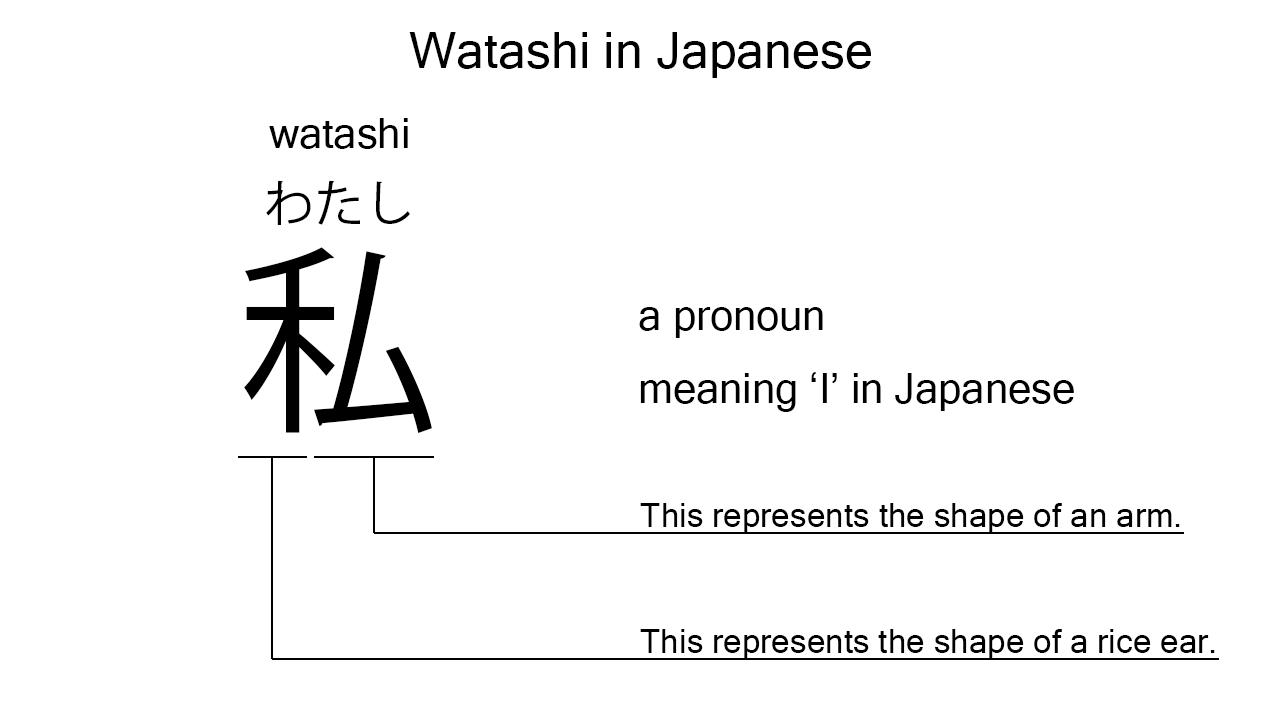What does “watashi” mean in Japanese?
Native speakers say watashi to mean ‘I’ in Japanese. This is the most widely-used first-person pronoun in Japanese, so many Japanese learners know it, I think. In this blog post, however, I will explain it in detail based on its kanji character. And also, I will explain how to use it through example sentences. My explanations would help Japanese learners understand watashi more clearly. Then, let’s get started!
Contents
Definition and meaning of “watashi”
Let me start with the definition and meaning of watashi.
- watashi – 私 (わたし) : a pronoun meaning ‘I’ in Japanese. Males use this mainly in formal situations; females use this in both formal and casual situations.
Probably, many Japanese learners know the fact that Japanese has a lot of first-person pronouns. Watashi is the most widely-used one. It is considered polite, so very acceptable in daily conversations as well as formal situations.
The definition and meaning are very simple and clear. To understand this pronoun more clearly, however, let me explain its kanji character in detail.
Watashi in kanji
The kanji character of watashi consists of the following two parts:
- 禾 : a kanji radical representing the shape of a rice ear.
- 厶 : a kanji character representing the shape of an arm.
These two parts tell us that the kanji character of watashi represents an arm reaching for a rice ear. This literal interpretation is not in line with the actual meaning. I think, however, the kanji character is still understandable as a metaphor for someone trying to draw attention to themself – trying to refer to themself – in a conversation.

When we meet new kanji characters, we should check their parts in detail to understand their meanings clearly and deeply. In many cases, kanji parts tell us a lot about the meanings of the characters they form. Actually, here, we could get the better understanding of watashi through the detailed check above.
So far, I’ve explained the definition and meaning of watashi together with its kanji character. Then, let me explain how to use it through the example sentences below.
How to say “I” in Japanese
watashi wa nihongo ga suki desu – 私は日本語が好きです (わたしはにほんごがすきです)
I love Japanese.
Below are the new words used in the example sentence.
- wa – は : a binding particle working as a case marker or topic marker. In the example, this works after watashi to make the subject in the sentence.
- nihongo – 日本語 (にほんご) : a noun meaning ‘Japanese’ or ‘the Japanese language’ in Japanese.
- ga – が : a case particle used to make the subject word or the object word in a sentence. In the example, this is used after nihongo to make the object in the sentence.
- suki – 好き (すき) : the stem part of the na-adjective, sukina, which means ‘favorite’ in Japanese. Native speakers, however, often use this as an individual word to mean ‘to like’ or ‘to love’ in Japanese. In the example, this is used to mean ‘to love’ in Japanese.
- desu – です : an auxiliary verb used after a noun or adjective to make it polite. Probably, this is well known as a part of Japanese desu form. In the example, this is used after suki to make it sound polite.
This is a typical usage of watashi. In this example, it works together with wa to become the subject in the sentence. Again, but it is polite and therefore very acceptable in formal situations. When we want to say “I” politely in Japanese, this pronoun is always a very good option.
Another example of “watashi”
watashi ga kanojo wo mamori masu – 私が彼女を守ります (わたしがかのじょをまもります)
I protect her.
Below are the new words used in the example sentence.
- kanojo – 彼女 (かのじょ) : a pronoun meaning ‘she’ in Japanese.
- wo – を : a case particle used to make the object word in a sentence. In the example, this is used after kanojo to make the object in the sentence.
- mamori – 守り (まもり) : one conjugation of the verb, mamoru, which means ‘to save’, ‘to keep’, ‘to protect’, or such in Japanese. In the example, it has been conjugated for the better connection with its following word.
- masu – ます : an auxiliary verb used after a verb to make it polite. Probably, this is well known as a part of Japanese masu form. In the example, this is used after mamori to make it sound polite.
This is another example of watashi. In this example, it works together with ga to become the subject in the sentence. Thanks to the role of ga, the pronoun is strongly emphasized as the subject. The Japanese sentence has been translated as just ‘I protect her’, but ‘I am the one who protects her’ is also very possible considering the strength of the subject.
Summary
In this blog post, I’ve explained the definition and meaning of watashi in detail based on its kanji character. And also, I’ve explained how to use it through the example sentences. Let me summarize them as follows.
- watashi – 私 (わたし) : a pronoun meaning ‘I’ in Japanese. Males use this mainly in formal situations; females use this in both formal and casual situations. This is the most widely-used first-person pronoun in Japanese. This kanji character represents an arm reaching for a rice ear. This literal interpretation is not in line with the actual meaning. I think, however, the kanji character is still understandable as a metaphor for someone trying to draw attention to themself – trying to refer to themself – in a conversation.
Hope my explanations are understandable and helpful for Japanese learners.
Leave a Reply